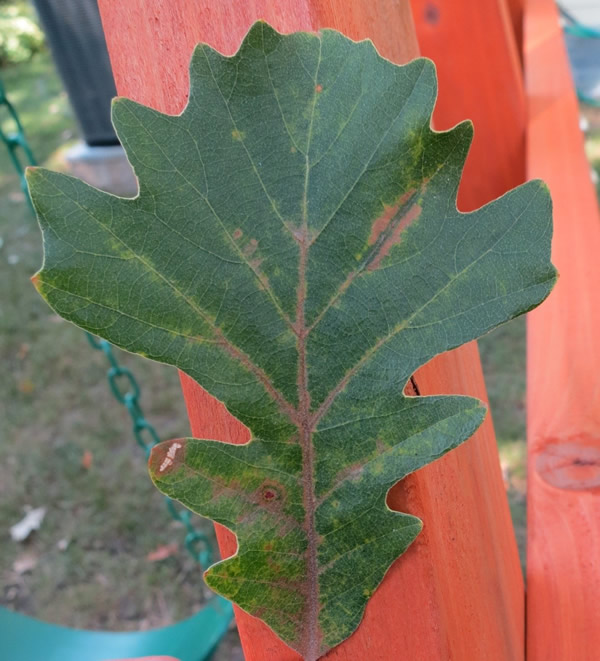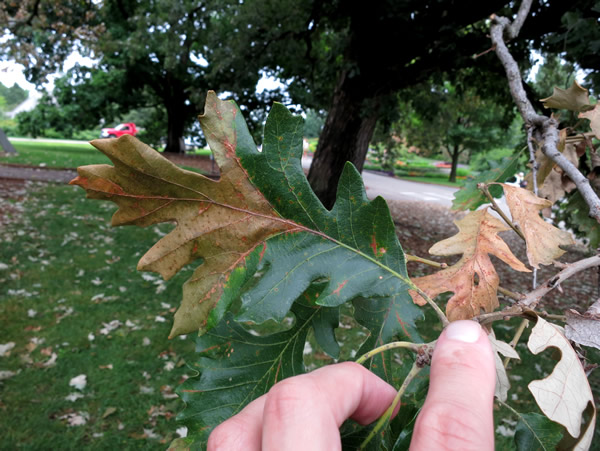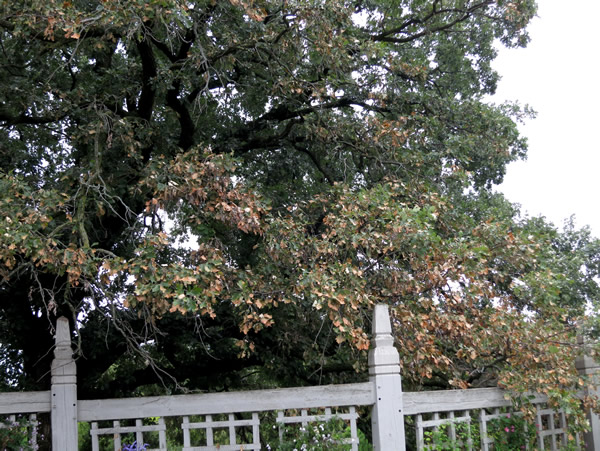Issue 10, August 30, 2019
Bur Oak Blight
The U of I Plant Clinic has received several tree samples suspected to be infected with bur oak blight (BOB). So far, for 2019, the plant clinic has confirmed BOB on two samples, originating in Cook and Henry counties. While still considered a relatively newly pathogen, we have seen an increase in awareness of this disease compared to just a few years ago.
Bur Oak Blight is a leaf disease caused by the fungus Tubakia iownesis. Several species of Tubakia are known to infect oak and cause minor leaf spots. However, Tubakia iowensis is the only species known to attack leaf petioles. Additionally, the pathogen will only infect Bur oak, particularly Quercus macrocarpa var. oliviformis. Dr. Tom Harrington of Iowa State University was first to identify BOB pathogen. Results from his research suggest that the pathogen is likely native to the region and has only recently become problematic due to a significant environmental change. Wet springs, with significantly more precipitation, have likely created a favorable environment for disease development. His research lab has also been keeping track of counties and states with trees confirmed to have BOB. A map with the current disease distribution can be found at the following link: http://www.public.iastate.edu/~tcharrin/BOB.html.
Symptoms
Bur oak blight is a late-season leaf blight. The earliest symptoms of Bur Oak Blight first appear in June as purple-brown spots on the underside leaf veins. In July, the spots expand, and purplish necrotic veins become noticeable on the upper leaf surface (Image 1). The most notable symptoms appear in August and September as leaf veins are killed as the infection progresses and a characteristic wedge-shaped necrotic area develops on the leaf blade (Image 2). Coalescing lesions and expanding vein necrosis may cause the leaf to die. Severely affected trees may have significant leaf mortality and/or leaves with scorched appearance (Image 3). Extensive premature defoliation is common, but many diseased leaves remain attached to the tree into the winter, well after healthy Bur oaks have dropped their leaves.
The retention of diseased leaves favors the pathogen and its spread because overwintering pustules remain attached to the tree and never lose contact with the host. In late April and May, fungal spores are produced and released from the pustules about the same time as new leaves are developing and expanding. Wet conditions promote spore dispersal to newly expanding leaves. Infection occurs before the leaves are fully developed. However, there is a latent period between infection and when the first symptoms appear in June.
Initially, infections may be limited to the lower branches. Symptoms intensify from year to year and progress from the lower limbs throughout the canopy.

Image 1. Purple-brown necrotic veins on the upper leaf surface associated with Bur Oak Blight

Image 2. Wedge-shape lesion characteristic of Bur Oak Blight

Image 3. Bur oak with lower canopy affected by Bur Oak Blight
Diseased leaf retention is currently one of the best ways to identify this disease in the field. Look for leaves and petioles attached from the previous growing season. Infected petioles will have black pustules or scars from previously attached pustules (Image 4). The other species of Tubakia that infect Bur oak are not known to produce these overwintering pustules.
Several successive years of severe infection and defoliation may severely weaken the host tree. Tree mortality has been attributed to secondary invaders such as the two-lined chestnut borer. Trees infected with BOB appear to have increased susceptibility to these secondary invaders.

Image 4. Branch with diseased petiole still attached from the previous growing season. Note the small black pustules.
Management Strategies
- Fortunately, not all bur oaks will be affected by this disease. Many bur oak trees have a resistance to this pathogen. It’s not uncommon to observe a healthy unaffected tree growing near a severely infected tree.
- If you suspect a BOB infection, have the disease diagnosis confirmed by a laboratory. The leaf blight and scorching symptoms of BOB can be confused with other common disease such as: oak wilt, oak anthracnose, and environmental stresses. Disease confirmation is important for providing accurate disease control strategies and recommendations. Suspect BOB samples can be submitted to the University of Illinois Plant Clinic. Information on general sample submission can be found on the plant clinic website (http://web.extension.illinois.edu/plantclinic/). For Bur Oak Blight sampling, collect branches and twigs with symptomatic and healthy leaves. Be sure to include branches with petioles from previous growing season still attached (See Image 4 for example)
- Raking diseased leaves will have little effect on controlling the disease. The primary infection occurs from the abundant spores produced from diseased petioles that remain attached to the tree.
- Boosting tree vigor may help the tree to limit and prevent secondary invaders. Pruning and removing branch dieback has been suggested to help reduce borer populations
- For high-value trees, Iowa State University found trunk injections of propiconazole to be effective at controlling the disease. Applications require specialized equipment and will need to be made by a certified professional.
- Injections should be made in late May or early June just after the leaves have fully expanded
- The recommended application rate is 8-10 mls per 1”DBH. Higher applications rates reportedly resulted in phytotoxicity to leaves. The rate will also need to be adjusted if the tree has significant branch dieback in the canopy.
- One application should last several years. Iowa State currently recommends repeat application only after a severe outbreak re-occurs.
References and Further Reading
2017 Video Presentation by Dr. Tom Harrington: https://vimeo.com/229174467/f19476b2a7
Published Research Article-- Harrington T, McNew D, Hye Young Y. Bur oak blight, a new disease on Quercus macrocarpa caused by Tubakia iowensis sp. nov. Mycologia January 2012;104(1):79-92.
Author:
Travis Cleveland